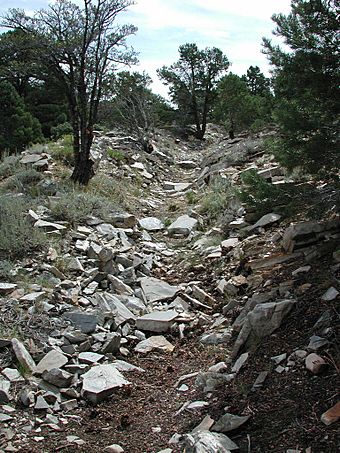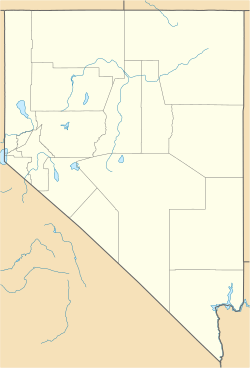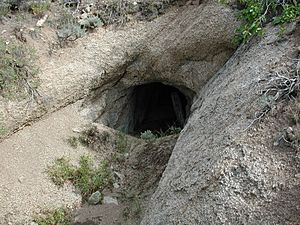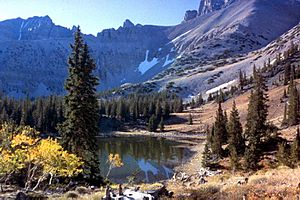Osceola Ditch facts for kids
Quick facts for kids |
|
|
Osceola (East) Ditch
|
|

Osceola Ditch
|
|
| Location | White Pine County, Nevada |
|---|---|
| Nearest city | Baker, Nevada |
| Built | 1890 |
| NRHP reference No. | 96000584 |
| Added to NRHP | June 06, 1996 |
The Osceola Ditch, also known as the East Ditch, was a special water channel built a long time ago, between 1889 and 1890. Its main job was to carry water from Lehman Creek in Nevada to a gold mining operation in a town called Osceola.
This ditch was very long, about 18 miles (29 km). It even had a 600-foot (180 m) tunnel and wooden channels called flumes to help the water flow. The project also included a rock dam and a gate at Stella Lake to control the water. The part of the ditch that reached Osceola was no longer used after the early 1900s. A fire in the 1940s completely destroyed it. Today, much of the East Ditch is found inside Great Basin National Park.
Contents
Discovering Gold at Osceola
Gold was first found in the Osceola mining area in 1872 by James Matteson and Frank Heck. This area was about 3 miles (4.8 km) west of where Great Basin National Park is now. Later, in 1877, John Versan found placer gold. This type of gold is found in loose bits, often in riverbeds.
The town of Osceola grew quickly, reaching about 1,500 people. Miners dug up almost $2 million worth of gold from the area. This included a very large gold piece, or gold nugget, that weighed 24 pounds (11 kg)!
The Need for More Water
Gold was also found in a nearby place called Dry Gulch. But getting this gold out needed a lot of work and a huge amount of water. A company called the Osceola Gravel Mining Company was formed to get this gold. They planned to use a method called hydraulic mining. This means using powerful jets of water to blast away dirt and gravel to find gold.
To do this, they first built the West Ditch between 1884 and 1885. However, this ditch did not bring enough water. So, in 1885, they started planning the East Ditch. They even bought the rights to use water from Absalom Lehman, who discovered the famous Lehman Caves in what is now Great Basin National Park.
How the Ditches Worked
The East Ditch was built to supply the Osceola Gravel Mining Company's gold mine. This type of mining needed huge amounts of water to wash away the gold-filled gravel and rocks. The East Ditch could deliver 2,500 miner's inches of water. A miner's inch is a way to measure how much water flows in a certain time. Another ditch, the West Ditch, could provide 1,100 miner's inches.
Building the East Ditch was very expensive, costing over $108,000 back then. The ditch was 4 feet (1.2 m) wide at the bottom and 2.5 feet (0.76 m) deep. It sloped downwards by 14 feet (4.3 m) for every mile (1.6 km) to keep the water flowing. It could carry 40 million US gallons (150 million L) of water every day!
Wooden Flumes and Equipment
The East Ditch had 14 sections made of wood, called flumes. These were like long wooden boxes or channels that carried water across uneven ground. One long flume in Lehman Canyon was 3,768 feet (1,148 m) long. These flumes were 4 feet (1.2 m) wide and 4 feet (1.2 m) deep. They sloped by 32 feet (9.8 m) for every mile (1.6 km).
The mining operation also had other important structures. There were four houses for the ditch keepers, who looked after the ditch. They also made big improvements to the mining area itself. This included making the water storage area bigger, adding new sluices (channels for washing gold), and using two 8-inch (20 cm) hydraulic monitors. These monitors were like giant nozzles that shot powerful streams of water.
Why the Mine Closed
Even with all these efforts, there was never quite enough water for the mining to reach its full potential. The mining operations had to be stopped in 1894 and again in 1896 because of water shortages. After eleven years, the Osceola Mine finally shut down for good.
There was a plan in 1906 to start a new company, but it never happened. The West Ditch was built before the East Ditch and stretched 16 miles (26 km) to the west side of the Snake Range. This ditch is not part of the historic site. Not much is left of the West Ditch today.
The East Ditch was added to the National Register of Historic Places in 1996. It no longer carries water and is covered by plants, but some parts of the wooden flumes can still be seen. The tunnel at Strawberry Creek has partly fallen in. Very little remains of the old town of Osceola itself.





